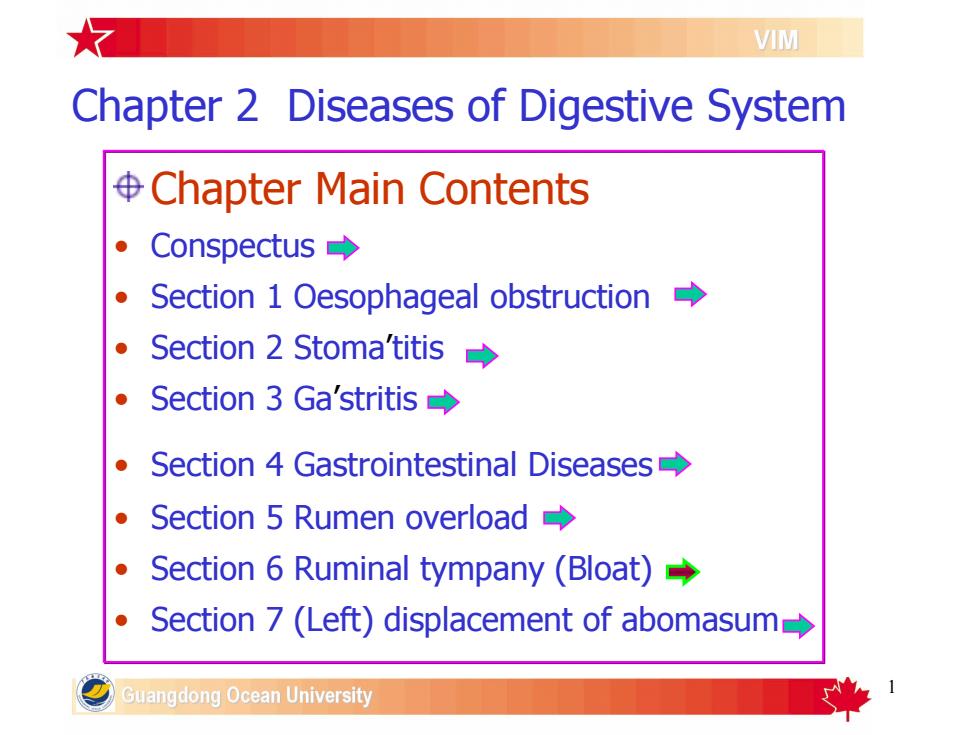
VIMChapter 2 Diseases of Digestive System$ Chapter Main ContentsConspectus+Section1Oesophageal obstructionSection 2 Stoma'titisSection 3 Ga'stritisSection4GastrointestinalDiseasesSection5RumenoverloadSection 6Ruminal tympany (Bloat)Section 7 (Left) displacement of abomasumGuangdong OceanUniversity
1 Chapter 2 Diseases of Digestive System Chapter Main Contents • Conspectus • Section 1 Oesophageal obstruction • Section 2 Stoma’titis • Section 3 Ga’stritis • Section 4 Gastrointestinal Diseases • Section 5 Rumen overload • Section 6 Ruminal tympany (Bloat) • Section 7 (Left) displacement of abomasum
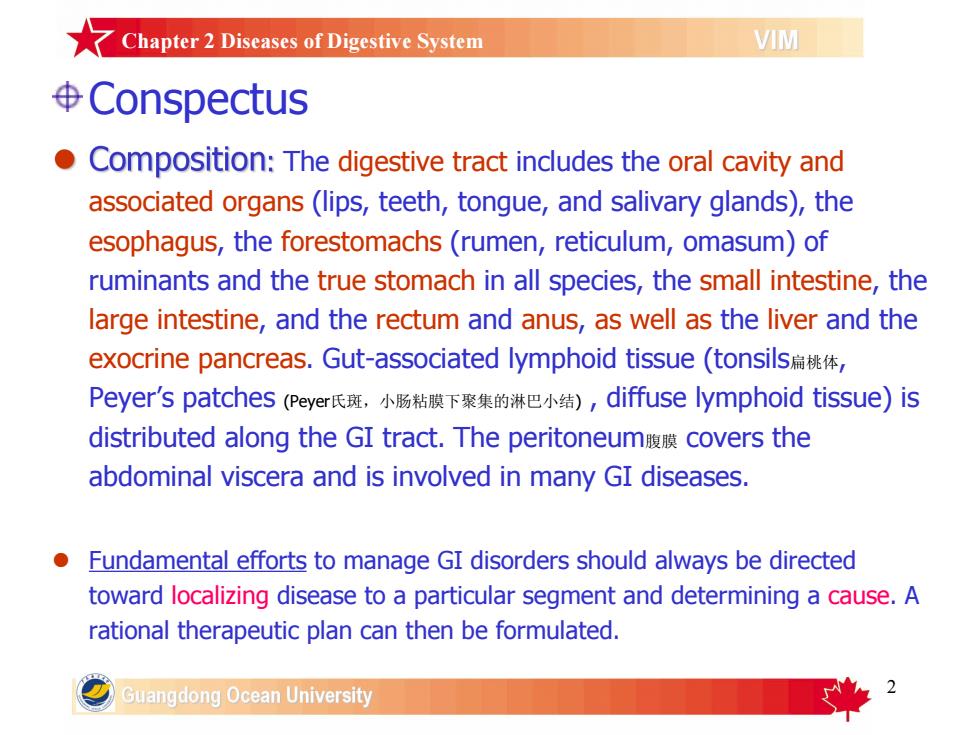
Chapter2Diseases ofDigestive SystemVIM$ConspectusComposition: The digestive tract includes the oral cavity andassociated organs (lips, teeth, tongue, and salivary glands), theesophagus, the forestomachs (rumen, reticulum, omasum) ofruminants and the true stomach in all species, the small intestine, thelarge intestine, and the rectum and anus, as well as the liver and theexocrine pancreas. Gut-associated lymphoid tissue (tonsils扁桃体,Peyer'spatches(Peyer氏斑,小肠粘膜下聚集的淋巴小结),diffuselymphoidtissue)isdistributed along the GI tract. The peritoneum腹膜 covers theabdominal viscera and is involved in many GI diseases.Fundamental efforts to manageGI disorders should always be directedtoward localizing disease to a particular segment and determining a cause.Arational therapeuticplan can then be formulated.Guangdong Ocean University
2 Conspectus The digestive tract includes the oral cavity and associated organs (lips, teeth, tongue, and salivary glands), the esophagus, the forestomachs (rumen, reticulum, omasum) of ruminants and the true stomach in all species, the small intestine, the large intestine, and the rectum and anus, as well as the liver and the exocrine pancreas. Gut-associated lymphoid tissue (tonsils扁桃体, Peyer’s patches (Peyer氏斑,小肠粘膜下聚集的淋巴小结) , diffuse lymphoid tissue) is distributed along the GI tract. The peritoneum腹膜 covers the abdominal viscera and is involved in many GI diseases. l Fundamental efforts to manage GI disorders should always be directed toward localizing disease to a particular segment and determining a cause. A rational therapeutic plan can then be formulated. Chapter 2 Diseases of Digestive System
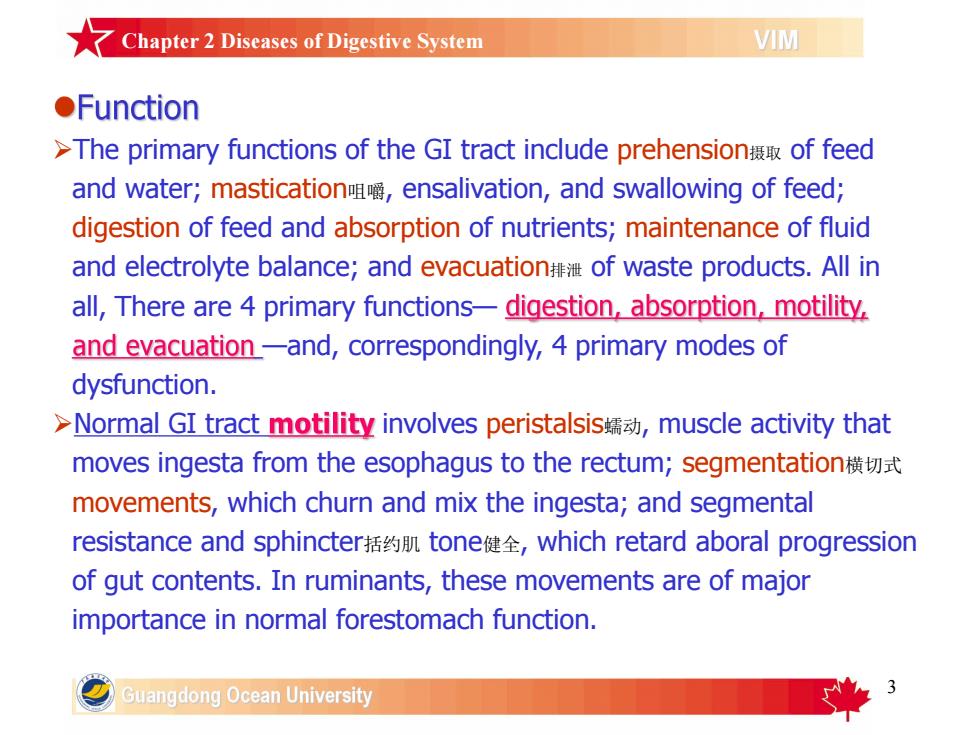
Chapter2Diseases of DigestiveSystemVIMFunction>TheprimaryfunctionsoftheGItract includeprehension摄取offeedand water;mastication咀嚼,ensalivation,and swallowing offeed;digestion of feed and absorption of nutrients; maintenance of fluidand electrolytebalance;and evacuation排泄of waste products.All inall, There are 4 primary functions- digestion, absorption, motility.and evacuationand, correspondingly, 4 primary modes ofdysfunction.>Normal GI tract motility involves peristalsis蠕动, muscle activity thatmovesingestafromtheesophagustotherectum;segmentation横切式movements, which churn and mix the ingesta; and segmentalresistanceandsphincter括约肌tone健全,whichretardaboralprogressionof gut contents. In ruminants, these movements are of majorimportanceinnormalforestomachfunction.GuangdongOceanUniversity
3 ØThe primary functions of the GI tract include prehension摄取 of feed and water; mastication咀嚼, ensalivation, and swallowing of feed; digestion of feed and absorption of nutrients; maintenance of fluid and electrolyte balance; and evacuation排泄 of waste products. All in all, There are 4 primary functions— —and, correspondingly, 4 primary modes of dysfunction. ØNormal GI tract involves peristalsis蠕动, muscle activity that moves ingesta from the esophagus to the rectum; segmentation横切式 movements, which churn and mix the ingesta; and segmental resistance and sphincter括约肌 tone健全, which retard aboral progression of gut contents. In ruminants, these movements are of major importance in normal forestomach function. Chapter 2 Diseases of Digestive System
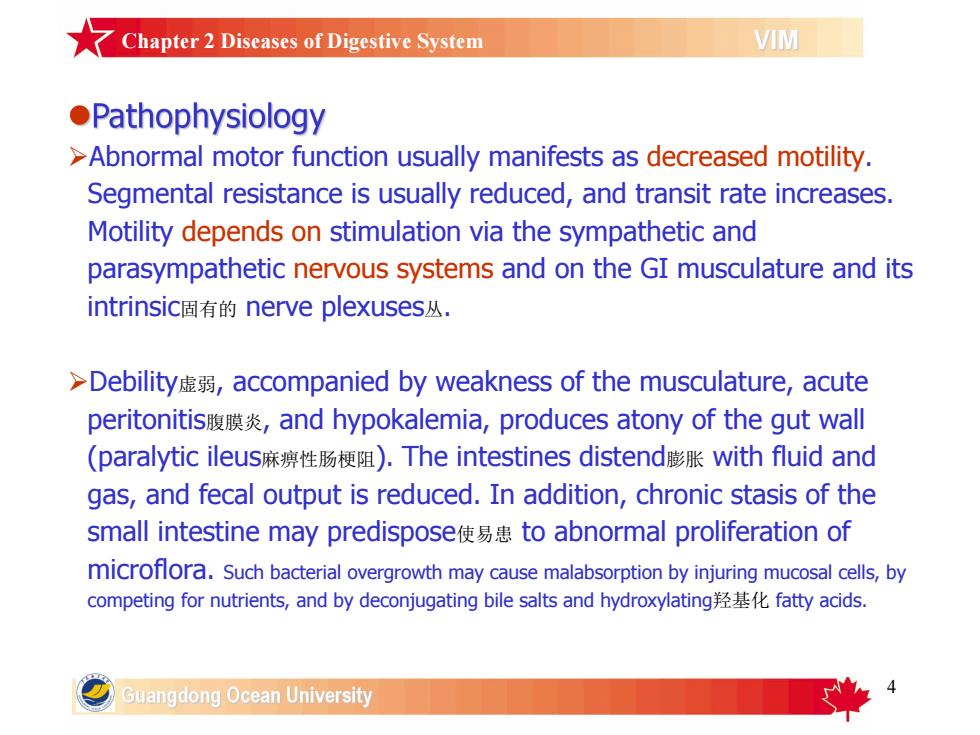
Chapter2Diseases of DigestiveSystemVIMPathophysiology>Abnormal motor function usually manifests as decreased motility.Segmental resistance is usually reduced, and transit rate increases.Motility depends on stimulation via the sympathetic andparasympathetic nervous systems and on the GI musculature and itsintrinsic固有的nerveplexuses丛,>Debility虚弱, accompanied by weakness of the musculature, acuteperitonitis腹膜炎,and hypokalemia,produces atonyof the gut wall(paralytic ileuS麻痹性肠梗阻).Theintestines distend膨胀withfluidandgas, and fecal output is reduced. In addition, chronic stasis of thesmall intestine may predispose使易患 to abnormal proliferation ofmicroflora. Such bacterial overgrowth may cause malabsorption by injuring mucosal cells, bycompeting for nutrients, and by deconjugating bile salts and hydroxylating羟基化 fatty acidsGuangdong Ocean University
4 ØAbnormal motor function usually manifests as decreased motility. Segmental resistance is usually reduced, and transit rate increases. Motility depends on stimulation via the sympathetic and parasympathetic nervous systems and on the GI musculature and its intrinsic固有的 nerve plexuses丛. ØDebility虚弱, accompanied by weakness of the musculature, acute peritonitis腹膜炎, and hypokalemia, produces atony of the gut wall (paralytic ileus麻痹性肠梗阻). The intestines distend膨胀 with fluid and gas, and fecal output is reduced. In addition, chronic stasis of the small intestine may predispose使易患 to abnormal proliferation of microflora. Such bacterial overgrowth may cause malabsorption by injuring mucosal cells, by competing for nutrients, and by deconjugating bile salts and hydroxylating羟基化 fatty acids. Chapter 2 Diseases of Digestive System
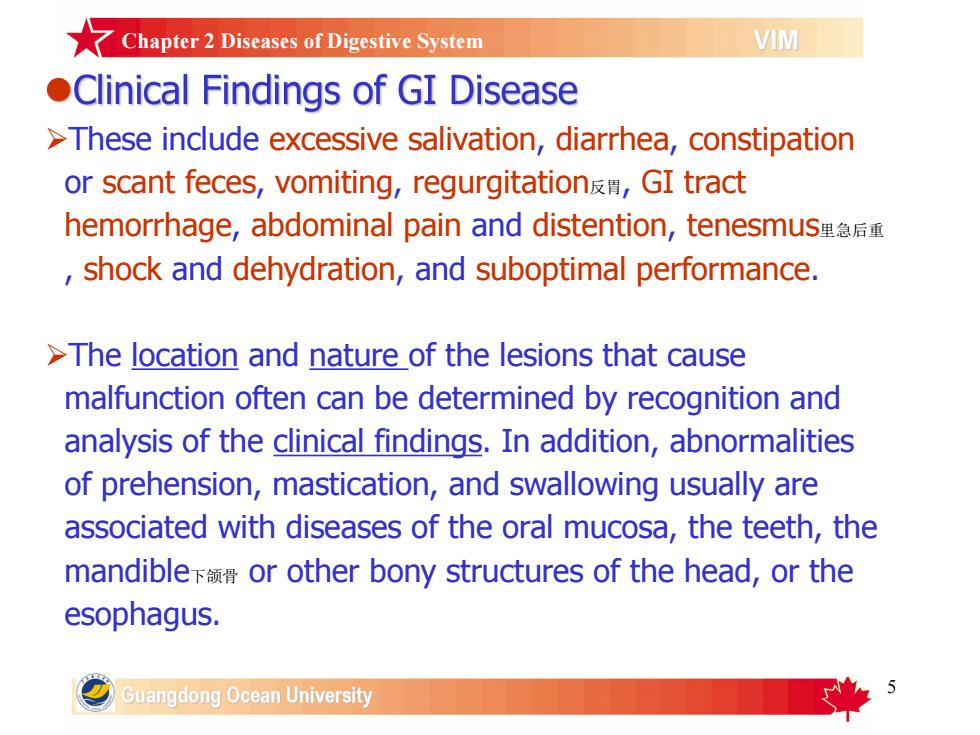
★Chapter2Diseases of DigestiveSystemVIMClinicalFindingsofGIDisease>These include excessive salivation, diarrhea,constipationor scantfeces,vomiting,regurgitation反,GItracthemorrhage, abdominal pain and distention,tenesmus里急后重,shock and dehydration, and suboptimal performance.Thelocationand natureof thelesionsthatcausemalfunction often can be determined by recognition andanalysis of the clinical findings. In addition, abnormalitiesof prehension,mastication,and swallowingusuallyareassociated with diseases ofthe oral mucosa, theteeth, themandible下领骨orotherbonystructuresofthehead,ortheesophagus.Guangdong Ocean University
5 ØThese include excessive salivation, diarrhea, constipation or scant feces, vomiting, regurgitation反胃, GI tract hemorrhage, abdominal pain and distention, tenesmus里急后重 , shock and dehydration, and suboptimal performance. ØThe location and nature of the lesions that cause malfunction often can be determined by recognition and analysis of the clinical findings. In addition, abnormalities of prehension, mastication, and swallowing usually are associated with diseases of the oral mucosa, the teeth, the mandible下颌骨 or other bony structures of the head, or the esophagus. Chapter 2 Diseases of Digestive System